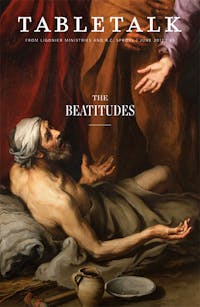
Request your free, three-month trial to Tabletalk magazine. You’ll receive the print issue monthly and gain immediate digital access to decades of archives. This trial is risk-free. No credit card required.
Try Tabletalk NowAlready receive Tabletalk magazine every month?
Verify your email address to gain unlimited access.
“Bless your heart.” “Have a blessed day.” “God bless this house.” “Let us say a blessing.” The words bless, blessed, and blessing are thrown around quite a bit in everyday conversation. So, when we read about the blessed ones in the Beatitudes (Matt. 5:3–12), the impact of the concept of blessing may get lost in translation. What sort of blessings are in view in the Beatitudes? Are these principles we are to strive for? Are they spiritual realities that are already true? Are they unattainable ideals? Such questions are closely related to the approach one takes to the Sermon on the Mount (Matt. 5–7) as a whole.
As to the latter question—how are we to read the Sermon on the Mount?—the answer is that the Lord’s sermon does not present an unattainable ideal that only underscores our inherent inability to realize the sermon’s demands. Instead, the Sermon on the Mount presents an ethical blueprint for disciples who make up the messianic community. The sermon provides the great principles that are to guide Christians to righteousness in practice, even as we follow the One who fulfills all righteousness (3:15).
It is within this framework that the Beatitudes stand at the gateway of the Sermon on the Mount. As biblical theologian Geerhardus Vos noted more than a century ago, “At the beginning [of the Sermon on the Mount] stand the beatitudes, engraven in golden script upon its portal, reminding us that we are not received by Jesus into a school of ethics but into a kingdom of redemption.” Therefore, to understand the blessings of the Beatitudes, we need to read Jesus’ sermon in the context of the entire canon of Scripture and the full scope of redemptive history. For indeed, the blessings of the Beatitudes are preeminently covenantal blessings.
To understand the biblical background to the Beatitudes, we turn first to Psalm 1:1–3:
Blessed is the man who walks not in the counsel of the wicked, nor stands in the way of sinners, nor sits in the seat of scoffers; but his delight is in the law of the Lord, and on his law he meditates day and night. He is like a tree planted by streams of water that yields its fruit in its season, and its leaf does not wither. In all that he does, he prospers.
Here the blessed one, the one who will flourish and prosper in his life, is the one who meditates on the law of God. Additionally, the term translated “blessed” in Psalm 1:1 in the Greek Old Testament is the same term used in the Greek New Testament for the blessed of the Beatitudes (makarios). Both Psalm 1 and the Beatitudes speak about the importance of God’s law for life. Thus, there is an ethical emphasis in these two texts: to know and to do God’s law is to be blessed.
We gain a fuller picture of what it means to be blessed by looking also at the blessings of Deuteronomy. For readers of the Pentateuch (Genesis–Deuteronomy), the language of blessings and curses has a familiar ring. Particularly at the end of Deuteronomy, we read about two paths that lie before the Israelites: the path of blessing and the path of cursing (Deut. 26–28; see also 11:26–28). The warnings against covenantal disobedience are clarion, as are the rewards for covenantal obedience. It is important to recognize that Deuteronomy is addressed originally to God’s covenant people who have been redeemed from Egypt (Deut. 1–4; see Ex. 19:5–6) and who are consequently instructed in covenantal obedience (Deut. 5–26; see Ex. 20–23). It is in this context that we read at the end of Deuteronomy a verse that is particularly relevant for the Beatitudes: “Happy are you, O Israel! Who is like you, a people saved by the Lord, the shield of your help, and the sword of your triumph! Your enemies shall come fawning to you, and you shall tread upon their backs” (Deut. 33:29). These words, which are the last recorded words of Moses, speak of the happiness or blessedness (makarios) of Israel, who are the people uniquely saved by the Lord. Already in the Old Testament, therefore, God’s saving work provides the proper context for understanding what it means to be covenantally blessed and shows that being blessed with salvation also entails the responsibility to live according to God’s law.
Consistent with this Old Testament emphasis on the priority of God’s action in redemption before the giving of the law, the Beatitudes are found in the context of Matthew’s gospel, wherein we find that Jesus saves His people from their sins (Matt. 1:21). Though the Promised Land may have been filled with darkness, the coming of Christ brought the great light of salvation for those dwelling in the shadow of death (4:14–16). The Beatitudes must thus be read in their wider context. Before we get to the Sermon on the Mount, Jesus has already been baptized, has overcome the devil in the face of temptation, has fulfilled Scripture in various ways, and has announced the inauguration of the kingdom of heaven. Only after we read of these aspects of the work of Christ are we introduced to the ethics of the kingdom in the Sermon on the Mount. And even here, the opening of the Sermon on the Mount speaks of the blessings of the redeemed (5:3–12). This does not mean, of course, that we are not to strive for the vision that is cast in the Beatitudes; but it does mean that redemption precedes living according to the Beatitudes. It is thus in light of the gift of redemption that we are to hunger and thirst after righteousness, be pure in heart, be meek, and so on. The Beatitudes are at once the blessings of the redeemed and the call for what the lives of the redeemed should look like. And these blessings are not abstract, for Jesus Himself shows us how the Beatitudes look in practice. For example, Jesus blesses the meek (5:5), and He Himself is meek and lowly of heart (11:29; 21:5). Likewise, Jesus blesses the merciful (5:7), and He Himself shows mercy (9:27; 15:22; 17:15; 20:30–31; see Hos. 6:6). Thus, the blessings of the redeemed are also ways that the redeemed reflect the character of their Savior.

Put another way, we see in the Sermon on the Mount, and the Beatitudes more particularly, the indicative-imperative dynamic that is so important in Scripture. The indicative refers to God’s great work of salvation to save His people, and the imperative refers to the call to obedience in light of God’s saving work. This can be seen summarily in the Old Testament, where the exodus from Egypt was followed by the giving of the Ten Commandments. This pattern is likewise seen in the Sermon on the Mount in the way that the coming of Christ’s kingdom precedes the giving of His law (see Matt. 4:17), and even more particularly in the way that the Beatitudes open the entire Sermon on the Mount.
Thus, the Sermon on the Mount is best understood when we take into consideration the many parallels between Moses and Jesus. In Exodus and Deuteronomy, we read of how Moses ascended the mountain to receive God’s law for the people of God and how he interceded for them. In like manner, Jesus proclaims the Sermon on the Mount from atop a mountain (Matt. 5:1) and also gives a law, though He speaks on His own authority (vv. 21–48; 7:28–29). And though Moses was a covenant mediator and a singularly important individual in Israel’s history (Ex. 24:6–8; 32:32), Moses was nevertheless a sinful man who could not look upon the face of God (33:23) and could not make final atonement for the people. In contrast, Jesus knows God the Father intimately (Matt. 11:25–27) and offers Himself as the perfect, final covenant sacrifice for His people (26:28). Moses ascends a mountain in prayer and reflects the glory of God (Ex. 34:29–30); when Jesus prays on a mountain, He shines with His own glory as Moses looks on in approval (Matt. 17:1–5; Luke 9:28–36). Through Moses the Lord fed the people with manna in the wilderness (Ex. 16; see John 6:32); Jesus feeds His people with His own body (Matt. 26:26; see 14:13–21; 15:32–39; John 6:1–14, 32–59). Jesus is like Moses, but is much greater than Moses. Put simply, Moses himself is among those who receive the blessings of the redeemed (Deut. 33:29), whereas Jesus uniquely redeems His people from their sins.
The Beatitudes do not teach us what we must do to earn the kingdom; the Beatitudes speak of the blessings of those who have been redeemed. Thus, the Beatitudes refer first of all to what we already are in Christ. To be sure, they also speak of those spiritual characteristics into which we ought to strive, by God’s grace, to grow more and more. So, because in Christ we are already meek, pure in heart, poor in spirit, and so on, we are then called to be those things. There is no contradiction here. For the indicative-imperative dynamic is commonly used in Scripture to refer to the covenantal blessings for the redeemed who live in accord with God’s law. The indicative—what we are—grounds the imperative—what God calls us to be. This is not new with Jesus, but was established already from the days of Moses.
